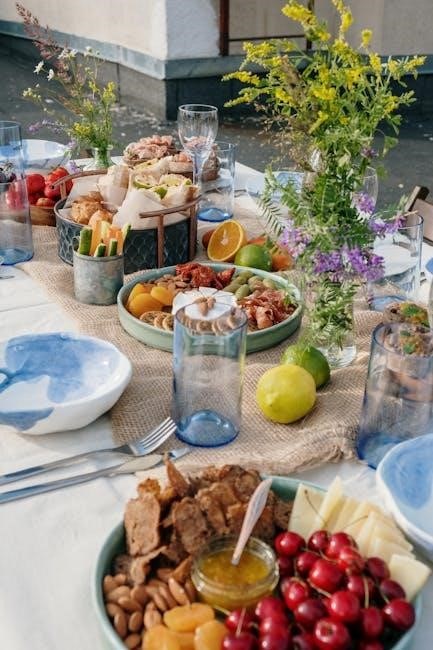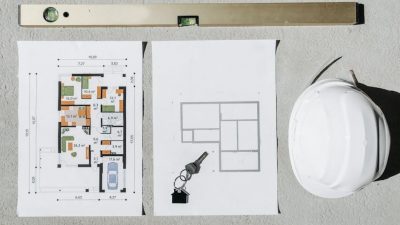These detailed plans provide a comprehensive guide to building an 8-foot picnic table, ideal for outdoor gatherings. Perfect for seating up to eight people, the design ensures durability, comfort, and style. With step-by-step instructions and material lists, it’s suitable for both DIY enthusiasts and professionals, offering a perfect blend of functionality and aesthetics for any setting.
Overview of the Project
This project involves building an 8-foot picnic table designed to accommodate up to eight people comfortably. The table is constructed using durable 2×6 and 2×4 lumber, ensuring stability and longevity. Its dimensions are 96 inches long, 62 inches wide, and 29 inches tall, making it spacious and functional for outdoor gatherings. The design includes attached benches for a classic, integrated look, with a table top made from five 7-10 boards supported by cross braces for added strength. The plans offer a traditional style with a focus on simplicity and practicality. Detailed step-by-step instructions, 3D diagrams, and a full cut list are provided to guide both beginners and experienced woodworkers. A shopping list and measurements ensure efficient preparation and execution. This project is ideal for those seeking a sturdy, attractive picnic table for family events or community spaces, perfect for enhancing outdoor living areas with a professional-quality result.
Importance of Detailed Plans
Detailed plans are essential for ensuring the successful construction of an 8-foot picnic table. They provide clear, step-by-step instructions that guide the builder through each phase of the project, from preparing the site to completing the final touches. With a comprehensive cut list, precise measurements, and material specifications, these plans minimize errors and save time. They also include 3D diagrams, which help visualize the assembly process, making it easier to understand how each component fits together. For beginners, detailed plans are particularly valuable as they offer a structured approach, reducing the risk of mistakes and fostering confidence. Experienced woodworkers benefit as well, as the plans streamline the process and ensure a professional-quality finish. By following these plans, builders can create a sturdy, attractive picnic table that meets their needs and enhances their outdoor spaces, making every project a success.
Benefits of an 8-Foot Picnic Table
An 8-foot picnic table offers numerous benefits, making it a practical and enjoyable addition to any outdoor space. Its spacious design can comfortably seat up to eight people, making it ideal for large families, gatherings, or social events. The table’s length ensures ample room for food, drinks, and other items, reducing clutter and enhancing convenience. Built with durable materials like 2×6 and 2×4 lumber, it provides long-lasting stability and withstands various weather conditions. The classic design complements most outdoor settings, from backyards to parks, while its simplicity allows for easy customization to match personal styles. Additionally, its size and structure make it a cost-effective option compared to smaller or more complex designs. The table’s versatility ensures it can serve as a focal point for meals, games, or relaxation, making it a valuable investment for years to come. Its benefits extend to both functionality and aesthetics, ensuring it remains a timeless choice for outdoor entertaining.

Materials and Tools Required
Building an 8-foot picnic table requires 2×4 lumber for the frame, 2×6 planks for the top and benches, weather-resistant screws, wood glue, and exterior wood finish. Essential tools include a saw, drill, and screwdriver.
Lumber Specifications
To build an 8-foot picnic table, you’ll need specific lumber sizes and quantities. The table top requires five 2×6 boards, each 8 feet long, to ensure a sturdy and spacious surface. For the frame, use 2×4 lumber for the legs, aprons, and cross braces. You’ll need three 2×4 boards at 8 feet long for the legs and aprons, and two additional 2×4 boards at 12 feet long for the cross braces and supports. Additionally, a 2×2 board measuring 8 feet long is necessary for extra stability. The benches are constructed using 2×6 lumber as well, with two boards at 8 feet long for the seat slats and two 2×4 boards at 12 feet long for the bench frames. Ensure all lumber is pressure-treated or naturally rot-resistant for outdoor durability. The total lumber required includes 3 pieces of 2×4 (8 feet), 7 pieces of 2×6 (12 feet), and 1 piece of 2×2 (8 feet), totaling 11 boards. Properly sizing and cutting the lumber is crucial for the project’s success.
Fasteners and Hardware
For assembling an 8-foot picnic table, the right fasteners are essential to ensure structural integrity and longevity. The primary hardware required includes 2-1/2″ self-tapping exterior wood screws, which are ideal for securing 2×4 and 2×6 lumber. You’ll need approximately 100 screws for the entire project. Additionally, 3″ galvanized lag screws are recommended for attaching the table legs to the frame, providing extra strength and stability. Carriage bolts (1/2″ x 6″) are used to secure the cross braces and seat supports, ensuring the table remains rigid under heavy use. Weather-resistant bolts and screws are crucial to prevent rust and corrosion over time. For added reinforcement, 2″ wood screws can be used to attach the bench slats to the frame. While nails can be used for temporary holding, screws and bolts are preferred for their superior holding power. Always choose hardware that is weather-resistant to withstand outdoor conditions and ensure the table’s durability.
Wood Types and Finishes
Choosing the right wood type and finish is crucial for durability and aesthetics in your 8-foot picnic table project. Cedar wood is a popular choice due to its natural resistance to rot, insects, and weathering, making it ideal for outdoor furniture. Pressure-treated lumber is another excellent option, as it is chemically treated to withstand moisture and pests. For a more budget-friendly option, redwood or cypress can be used, offering similar durability at a lower cost. If sustainability is a priority, consider using reclaimed or composite materials, which combine wood fibers with synthetic components for added strength and low maintenance. Once the wood is selected, apply a waterproof sealant or UV-protective finish to safeguard it from the elements. Stains or paints can also enhance the appearance while providing additional protection. Regularly reapplying finishes ensures the table remains in great condition for years to come.

Step-by-Step Assembly Guide

Start by cutting lumber to size, then assemble the frame using screws. Attach the table top securely, followed by the benches. Sand and finish with sealant for durability and a polished look.

Preparing the Site and Tools
Before starting your project, ensure your workspace is clean, flat, and well-ventilated. Gather all necessary tools, such as a circular saw, drill, measuring tape, square, and safety glasses. Organize your materials to avoid delays. A sturdy workbench or sawhorses will help in cutting and assembling components. Clear the area of debris to prevent accidents and ensure proper workflow. If working outdoors, check the weather to avoid rain or extreme heat. Wear protective gear, including gloves and a dust mask, especially when cutting or sanding wood. Double-check that all power tools are in good working condition and that batteries are charged. Having a well-prepared workspace and tools will streamline the assembly process and ensure accuracy in your cuts and measurements. A organized setup also reduces the risk of errors, making the project more enjoyable and efficient. Proper preparation is key to achieving professional-grade results.
Cutting the Lumber to Size
Begin by carefully measuring and cutting the lumber according to the plans. Use a circular saw or miter saw for precise cuts, ensuring accuracy to maintain the table’s structural integrity. For an 8-foot picnic table, cut the 2×6 boards for the table top and 2x4s for the frame and benches. Measure each piece twice before cutting to avoid errors. Sort and label the cut pieces to keep track of their intended use. Use a square to ensure all cuts are straight and aligned properly. Sand the cut edges to smooth them out and remove splinters. Double-check the measurements against the plans to confirm every piece fits together seamlessly. Proper cutting is foundational to the success of the project, so take your time and work methodically. A well-organized cutting process ensures the assembly will be straightforward and stress-free.
Assembling the Table Frame
Start by assembling the table frame using 2×4 lumber for the legs and 2×6 boards for the aprons and supports. Use 2-1/2″ self-tapping screws to secure the pieces together. Begin by constructing the frame’s base, ensuring the legs are evenly spaced and the aprons are properly aligned. Use clamps to hold the pieces in place while drilling pilot holes to prevent splitting the wood. Attach the cross supports between the legs to add stability and ensure the frame is square. Once the base is complete, attach the side rails and top supports, making sure all joints are secure. Use a level to ensure the frame is even and plumb. Tighten all screws firmly but avoid over-tightening, which could strip the wood. Allow the frame to sit for a few minutes before moving on to the next step. This step is critical for ensuring the table’s structural integrity and longevity.
Attaching the Table Top
Position the five 2×6 boards, each 8 feet long, evenly spaced across the frame. Clamp them securely to maintain alignment. Pre-drill pilot holes in the boards to prevent splitting. Attach the table top boards to the frame using 2-1/2″ screws, ensuring a flat and even surface. Check for proper alignment and stability before finalizing. Sand and finish as desired for a polished look.
Adding the Benches
Begin by assembling the bench frames using 2×4 lumber, ensuring they match the table’s height and width. Attach the bench tops, constructed from 2×6 boards, to the frames. Securely fasten the benches to the table’s side supports with 2-1/2″ screws. Ensure the benches are aligned with the table for a seamless look. Sand the edges for comfort and apply a finish to protect the wood. Test the benches for stability and make adjustments if necessary. This completes the seating portion, providing ample space for gatherings.
Sanding and Finishing
Once the table and benches are assembled, sand all surfaces to smooth out any rough edges or splinters. Start with medium-grit sandpaper (80-100 grit) and progress to finer grits (120-150) for a polished finish. Pay special attention to areas where people will sit or place their hands. After sanding, wipe down the entire structure with a clean cloth to remove dust. Apply a weather-resistant wood finish, such as stain, sealant, or paint, to protect the picnic table from outdoor elements. Follow the manufacturer’s instructions for application and drying times. Allow the finish to cure completely before using the table. For added durability, consider applying a second coat. Proper sanding and finishing ensure the picnic table is not only functional but also visually appealing and long-lasting.

Design Variations and Customization
Explore various designs, from traditional to modern styles, including hexagon and folding options. Customize with detached benches, decorative elements, or unique finishes to match your outdoor space and personal preferences perfectly.
Traditional vs. Modern Designs
When choosing between traditional and modern designs for your 8-foot picnic table, consider the aesthetic and functionality you desire. Traditional designs often feature classic, timeless looks with simple lines and a sturdy structure, typically made from natural wood like cedar or pine. These designs emphasize durability and blend seamlessly into rustic or countryside settings. Modern designs, on the other hand, incorporate sleek, contemporary elements such as minimalist frames, rounded edges, or even metal accents for a polished appearance. Some modern plans also include innovative features like detachable benches or folding mechanisms for easy storage.
Both styles are well-suited for outdoor spaces, but the choice depends on your personal preference and the surrounding environment. Traditional designs are ideal for parks or gardens, while modern designs complement urban or backyard decks. Many 8-foot picnic table plans offer customizable options, allowing you to mix elements from both styles to create a unique piece that reflects your taste.
Detached Bench Options
Detached bench options for an 8-foot picnic table offer flexibility and convenience, allowing for more seating arrangement possibilities. These benches are separate from the table, making it easier to accommodate guests and create a more open layout. Many plans include designs for individual benches that can be placed on either side or at both ends of the table. Detached benches are particularly useful for larger gatherings, as they provide additional seating without being fixed in place. They also simplify cleaning and maintenance, as each piece can be moved independently. Some designs feature foldable or stackable benches, adding practicality for storage during off-peak times. The detached bench option is ideal for those who value adaptability and ease of use in their outdoor furniture setup. This feature is often highlighted in 8-foot picnic table plans, catering to various preferences and needs for functionality.
Hexagon Picnic Table Designs
Hexagon picnic table designs offer a unique and visually appealing alternative to traditional rectangular tables. These plans are available in PDF formats and provide detailed instructions for constructing a six-sided table that can accommodate larger groups comfortably. The hexagon design is ideal for outdoor settings, such as parks, gardens, or backyard gatherings, as it creates a more intimate and inclusive seating arrangement. Many hexagon picnic table plans include options for detached benches, allowing for greater flexibility in seating configurations. The design also enhances durability, as the weight is evenly distributed across multiple points. With step-by-step guides and material lists, these plans cater to both novice and experienced woodworkers. The hexagon shape not only adds aesthetic value but also ensures that everyone seated has easy access to the table. This design is perfect for those looking to create a modern and functional outdoor dining space that stands out from traditional designs.
Folding Picnic Table Plans
Folding picnic table plans are a practical solution for outdoor enthusiasts who need a space-saving, portable dining option. These designs allow the table to be easily folded and stored, making them ideal for events, camping trips, or small backyard spaces. Many plans include hinges and latches to ensure the table remains secure when in use and folds neatly when not needed. The 8-foot folding picnic table is a popular choice, offering ample seating for up to eight people while maintaining portability. Constructed with durable materials like cedar or pressure-treated pine, these tables are designed to withstand outdoor conditions. The folding mechanism is typically simple, involving a hinge system that connects the table top and benches. Detailed PDF plans guide DIYers through the process, ensuring a sturdy and functional final product. This design is perfect for those seeking convenience, versatility, and easy assembly without compromising on style or comfort.

Safety and Maintenance Tips
Ensuring safety and durability is crucial for your 8-foot picnic table. Regularly inspect for wear and tear, apply protective finishes, and clean surfaces. Check hardware for tightness to maintain structural integrity and prevent damage.
Ensuring Structural Integrity
Structural integrity is critical for an 8-foot picnic table to ensure safety and longevity. Start by using high-quality, weather-resistant lumber like 2×6 and 2×4 boards, as specified in the plans. Proper joints, such as lap or mortise and tenon, provide added strength. Use exterior-grade screws or bolts to secure connections, avoiding nails for better durability. Ensure all cuts are precise to fit components perfectly, and cross-braces are installed to prevent wobbling. Sand all edges to smooth them out and apply a protective finish to shield the wood from moisture. Regularly inspect the table for signs of wear or rot and make repairs promptly. Following the plans’ detailed instructions, including 3D diagrams, helps maintain structural soundness. Proper assembly and materials ensure the table can withstand heavy use and harsh weather conditions, making it a reliable outdoor fixture for years to come.
Regular Maintenance Practices
Regular maintenance is essential to extend the life of your 8-foot picnic table. Start by cleaning the surface regularly with a mild detergent to remove dirt and stains. Inspect the table and benches for any signs of rot, cracks, or loose joints, addressing these issues promptly. Apply a waterproof sealant or wood finish annually to protect the lumber from moisture damage. During harsh weather seasons, consider covering the table or storing it in a sheltered area to prevent warping or splitting. Check all fasteners and tighten them as needed to maintain structural integrity. Additionally, sand down any rough edges or splintered wood to ensure safety. Following these maintenance practices will keep your picnic table looking its best and ensure it remains a durable and comfortable outdoor gathering spot for years to come. Consistent care will protect your investment and preserve the table’s functionality and appearance.

Tips for Beginners
Start with clear plans and measure accurately to avoid errors. Use proper tools and materials, ensuring all cuts are precise. Follow step-by-step instructions and practice safety to achieve a sturdy and professional finish.
Measuring and Cutting Accuracy
Precision is crucial when working with 8-foot picnic table plans. Accurate measurements ensure the table’s structural integrity and proper fit of all components. Start by using a tape measure and carpenter’s square to mark lumber precisely. Double-check all measurements before cutting to avoid errors. Invest in a sharp circular saw or miter saw for clean cuts. Clamp lumber securely during cutting to prevent movement, which can lead to inaccuracies. For best results, measure from the same reference point consistently. Consider using a cutting guide or jig to maintain consistency, especially for repetitive cuts. Sand edges post-cutting to smooth surfaces. Always follow safety guidelines, wearing protective eyewear and keeping the work area clear. By prioritizing accuracy, you’ll achieve a professional-looking picnic table that’s both durable and visually appealing. Practice on scrap wood first to refine your technique, ensuring confidence in your final project.
Using Plans Effectively

Maximizing the potential of 8-foot picnic table plans requires a systematic approach. Begin by thoroughly reviewing the PDF document, ensuring understanding of all components, measurements, and assembly steps. Highlight key sections for quick reference during the build. Create a shopping list based on the materials specified to avoid missing essential items. Prioritize organizing tools and workspace before starting, enhancing efficiency. Follow each step sequentially, as deviations can lead to fit issues. Utilize the included diagrams and 3D illustrations to visualize the project better. If unsure about a step, consider practicing on scrap lumber or seeking additional resources. Maintain a clean workspace to reduce errors and ensure safety. By adhering closely to the plans and taking advantage of the detailed instructions, you can achieve a professional-grade picnic table tailored to your needs. Effective plan usage not only saves time but also guarantees a polished final product.

Advanced Woodworking Techniques
Advanced techniques like mortise-and-tenon joints and decorative carvings enhance the picnic table’s durability and aesthetics. These methods ensure a sturdy, long-lasting structure while adding visual appeal for a professional finish.
Using Joints for Durability
When building an 8-foot picnic table, incorporating strong joints ensures long-lasting durability, especially for outdoor use. Traditional methods like lap joints and mortise-and-tenon connections provide excellent structural integrity. These techniques distribute weight evenly and withstand environmental stress. For added strength, use weather-resistant screws and wood glue to secure joints. Properly aligned and tightly fitted joints prevent wobbling and prolong the table’s lifespan. Consider reinforcing with metal brackets for extra stability, especially in high-traffic areas. Detailed plans often include diagrams for precise joint construction, making it easier to achieve professional results. By prioritizing joint quality, you ensure the picnic table remains sturdy and safe for years of enjoyment. This attention to detail is crucial for creating a durable and reliable outdoor seating solution.
Adding Decorative Elements
Enhance your 8-foot picnic table with decorative elements to give it a personalized touch. Consider adding engravings, carved designs, or painted patterns to make it visually appealing. A coat of vibrant paint or stain can transform the table into a colorful centerpiece for your outdoor space. For a rustic look, leave the wood natural and apply a protective sealant to maintain its charm. Adding decorative trim or molding along the edges can also elevate the design. Incorporate recessed areas for built-in cup holders or trays for added functionality. Personalized engravings, such as family names or dates, add sentimental value. These decorative touches not only beautify the table but also create a welcoming atmosphere for gatherings. Whether modern or traditional, customizing your picnic table ensures it stands out while blending seamlessly with your surroundings.









